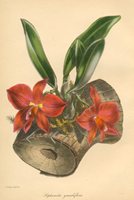
The youngest of 8 children, Joseph Paxton (1803-1865) remained at school until he was 14, so had the advantage of being able to read and write. He first worked as a garden boy, with his father at Milton Bryan Manor House near their home in Bedfordshire. After experience with gardening and landscaping while working with his brothers at other grand estates Joseph went to work at a nursery garden in Kensington - from where he was admitted as a student gardener in the new Horticultural Society experimental garden at Chiswick in London - where the land was leased from William Spencer Cavendish (1790-1858), the 6th Duke of Devonshire. The following year Paxton was promoted to foreman in charge of the Horticultural Society's 13.3ha arboretum - on a respectable wage of 18 shillings a week (47 pounds a year).
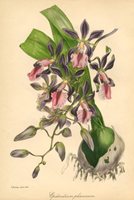
Intelligent and hard working, Joseph Paxton had wider knowledge and experience than most older gardeners. The Duke often walked with Joseph and appreciated that he spoke clearly as the Duke was nearly deaf. At the age of 23 Joseph Paxton was appointed head gardener of the Duke of Devonshire's Chatsworth Estate in Derbyshire on a salary of 70 pounds a year.
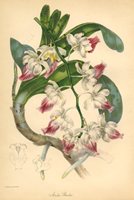 Paxton wrote, “I left London by the Comet Coach for Chesterfield and arrived at Chatsworth at half past four o’clock in the morning of the ninth of May, 1826. As no person was to be seen at that early hour, I got over the greenhouse gate by the old covered way, explored the pleasure grounds and looked round the outside of the house. I then went down to the kitchen gardens, scaled the outside wall and saw the whole place, set the men to work there at six o’clock; then returned to Chatsworth and got Thomas Weldon to play me the water works, and afterwards went to breakfast with poor dear Mrs Gregory and her niece. The latter fell in love with me and I with her and thus completed my first morning’s work at Chatsworth before nine o’clock”.
Paxton wrote, “I left London by the Comet Coach for Chesterfield and arrived at Chatsworth at half past four o’clock in the morning of the ninth of May, 1826. As no person was to be seen at that early hour, I got over the greenhouse gate by the old covered way, explored the pleasure grounds and looked round the outside of the house. I then went down to the kitchen gardens, scaled the outside wall and saw the whole place, set the men to work there at six o’clock; then returned to Chatsworth and got Thomas Weldon to play me the water works, and afterwards went to breakfast with poor dear Mrs Gregory and her niece. The latter fell in love with me and I with her and thus completed my first morning’s work at Chatsworth before nine o’clock”.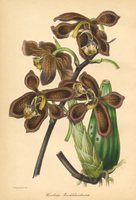
The following year Paxton married the housekeeper's niece, Sarah Bown (1800-1871) - and for the rest of their life Paxton benefitted greatly from Sarah managing their affairs while Joseph dedicated his life to bringing the duke's and his own grand ideas to reality.
Joseph Paxton had improved his knowledge by reading gardening publications by Scottish botanist and garden designer John Claudius Loudon (1783-1843). He was able to write and speak well, and encouraged the younger gardeners at Chatsworth to learn as much as they could to improve their own positions. Five years after arriving at Chatsworth, Paxton and Joseph Harrison (gardener at nearby Wortley Hall) began compiling a monthly magazine,
The Horticultural Register, and general magazine of all interesting discoveries connected with Natural History and Rural Subjects. It was an inexpensive publication with reviews of other writers' articles, simplified excerpts from
Loudon's Gardener's Magazine, and a few full-page engravings of flowers.
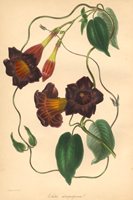
Paxton wrote to people who contacted him from around England. He corresponded with people who sent botanical specimens from around the world, and wrote that in response to "
the great general interest that has so generally been taken in the welfare of the New Colony, Swan River, in Western Australia" the First Edition of the magazine included "
a few Extracts from Letters... received from two gentlemen, who were among the earliest agricultural settlers at that place".
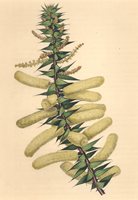
Joseph Paxton had improved his knowledge by reading gardening publications by Scottish botanist and garden designer John Claudius Loudon (1783-1843). He was able to write and speak well, and encouraged the younger gardeners at Chatsworth to learn as much as they could to improve their own positions. Five years after arriving at Chatsworth, Paxton and Joseph Harrison (gardener at nearby Wortley Hall) began compiling a monthly magazine,
The Horticultural Register, and general magazine of all interesting discoveries connected with Natural History and Rural Subjects. It was an inexpensive publication with reviews of other writers' articles, simplified excerpts from
Loudon's Gardener's Magazine, and a few full-page engravings of flowers.
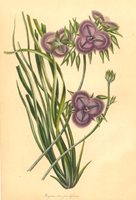
Paxton wrote to people who contacted him from around England. He corresponded with people who sent botanical specimens from around the world, and wrote that in response to "
the great general interest that has so generally been taken in the welfare of the New Colony, Swan River, in Western Australia" the First Edition of the magazine included "
a few Extracts from Letters... received from two gentlemen, who were among the earliest agricultural settlers at that place".
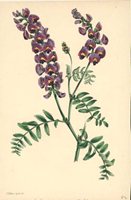
S.T__ Esquire had written in Feb. 9, 1831 that their
grant of land on the Swan River was a fine one, buildings had been erected, several acres were ploughed, and "Sheep thrive here beyond anything I could have expected; our stock of Merinos has already more than doubled, - we lost one of them the other day to the native dogs... There has been a large extent of good land, very thinly wooded, discovered beyond the hills, about forty miles from our farm; we have taken up the remainder of our grant there. We are still obliged to cut salted meat when we cannot get kangaroo..."
- and on May 7, 1831. "
We are now very busy getting in our Wheat, and making our gardens; many things we planted last year, failed, from being planted out of season.
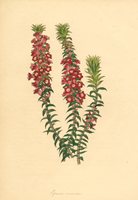
It was to be the first of a number of publications by Paxton. To celebrate Spring I have changed the mixed subjects on the
Home Page carousel to feature the stunning lithographs and engravings from his grandest horticultural publication, his
Magazine of Botany, and Register of Flowering Plants. Joseph Paxton botanical prints currently in stock can be found under
Antique Prints> Botany> Joseph Paxton.
For more information on the Industrious Joseph Paxton there is an editorial in the Spring edition of Antiques to Vintage magazine (at Newsagents now).
If you would like to read my full editorial, please email me. (See Home Page)